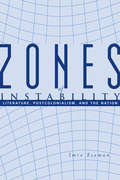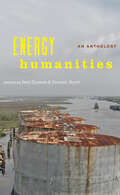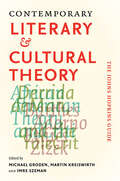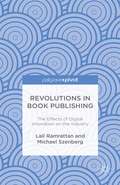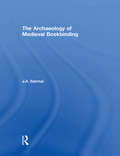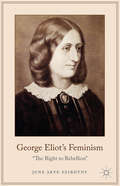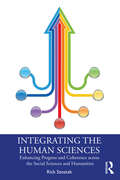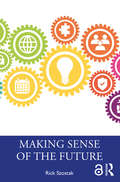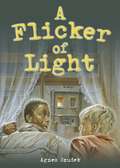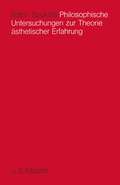- Table View
- List View
Truth without Predication: The Role of Placing in the Existential There-Sentence (Palgrave Studies in Pragmatics, Language and Cognition)
by R. SzekelyThis book contains an original analysis of the existential there-sentence from a philosophical-linguistic perspective. At its core is the claim that there-sentences' form is distinct from that of ordinary subject–predicate sentences, and that this fundamental difference explains the construction's unusual grammatical and discourse properties.
The Ruined Elegance: Poems
by Fiona Sze-LorrainIn her new collection, Fiona Sze-Lorrain offers a nuanced yet dynamic vision of humanity marked by perils, surprises, and the transcendence of a "ruined elegance." Through an intercultural journey that traces lives, encounters, exiles, and memories from France, America, and Asia, the poet explores a rich array of historical and literary allusions to European masters, Asian sources, and American influences. With candor and humor, each lyrical foray is sensitive to silence and experience: "I want to honor / the invisible. I'll use the fog to see white peaches." There are haunting narratives from a World War II concentration camp, the Stalinist Terror, and a persecuted Tibet during the Cultural Revolution. There are also poems that take as their point of departure writings, paintings, sketches, photographs, and music by Gu Cheng, Giorgio Caproni, Bonnard, Hiroshige, Gao Xingjian, Kertész, and Debussy, among others. Grounded in the sensual, these poems probe existential questionings through inspirations from nature and the impermanent earth. Described by the Los Angeles Review of Books as "a high lyricist who refuses to resort to mere lyricism in order to articulate her experience," Sze-Lorrain renews her faith in music and poetic language by addressing the opposing aesthetics of "ruins" and "elegance," and how the experience of both defies judgment.
The Ruined Elegance: Poems
by Fiona Sze-LorrainIn her new collection, Fiona Sze-Lorrain offers a nuanced yet dynamic vision of humanity marked by perils, surprises, and the transcendence of a "ruined elegance." Through an intercultural journey that traces lives, encounters, exiles, and memories from France, America, and Asia, the poet explores a rich array of historical and literary allusions to European masters, Asian sources, and American influences. With candor and humor, each lyrical foray is sensitive to silence and experience: "I want to honor / the invisible. I'll use the fog to see white peaches." There are haunting narratives from a World War II concentration camp, the Stalinist Terror, and a persecuted Tibet during the Cultural Revolution. There are also poems that take as their point of departure writings, paintings, sketches, photographs, and music by Gu Cheng, Giorgio Caproni, Bonnard, Hiroshige, Gao Xingjian, Kertész, and Debussy, among others. Grounded in the sensual, these poems probe existential questionings through inspirations from nature and the impermanent earth. Described by the Los Angeles Review of Books as "a high lyricist who refuses to resort to mere lyricism in order to articulate her experience," Sze-Lorrain renews her faith in music and poetic language by addressing the opposing aesthetics of "ruins" and "elegance," and how the experience of both defies judgment.
Zones of Instability: Literature, Postcolonialism, and the Nation
by Imre SzemanAttempts by writers and intellectuals in former colonies to create unique national cultures are often thwarted by a context of global modernity, which discourages particularity and uniqueness. In describing unstable social and political cultures, such "third-world intellectuals" often find themselves torn between the competing literary requirements of the "local" culture of the colony and the cosmopolitan, "world" culture introduced by Western civilization.In Zones of Instability, Imre Szeman examines the complex relationship between literature and politics by exploring the production of nationalist literature in the former British empire. Taking as his case studies the regions of the British Caribbean, Nigeria, and Canada, Szeman analyzes the work of authors for whom the idea of the"nation" and literature are inexorably entwined, such as Chinua Achebe, Wole Soyinka, C.L.R. James, Frantz Fanon, and V.S. Naipaul. Szeman focuses on literature created in the two decades after World War II, decades in which the future prospects for many colonies went from extreme political optimism to extreme political disappointment. He finds that the "nation" can be read as that space in which literature is thought to be able to conjoin two things that history has separated—the writer and the people.
A Companion to Critical and Cultural Theory
by Imre Szeman Sarah Blacker Justin SullyThis Companion addresses the contemporary transformation of critical and cultural theory, with special emphasis on the way debates in the field have changed in recent decades. Features original essays from an international team of cultural theorists which offer fresh and compelling perspectives and sketch out exciting new areas of theoretical inquiry Thoughtfully organized into two sections – lineages and problematics – that facilitate its use both by students new to the field andadvanced scholars and researchers Explains key schools and movements clearly and succinctly, situating them in relation to broader developments in culture, society, and politics Tackles issues that have shaped and energized the field since the Second World War, with discussion of familiar and under-theorized topics related to living and laboring, being and knowing, and agency and belonging
A Companion to Critical and Cultural Theory
by Imre Szeman Sarah Blacker Justin SullyThis Companion addresses the contemporary transformation of critical and cultural theory, with special emphasis on the way debates in the field have changed in recent decades. Features original essays from an international team of cultural theorists which offer fresh and compelling perspectives and sketch out exciting new areas of theoretical inquiry Thoughtfully organized into two sections – lineages and problematics – that facilitate its use both by students new to the field andadvanced scholars and researchers Explains key schools and movements clearly and succinctly, situating them in relation to broader developments in culture, society, and politics Tackles issues that have shaped and energized the field since the Second World War, with discussion of familiar and under-theorized topics related to living and laboring, being and knowing, and agency and belonging
Energy Humanities: An Anthology
by Imre Szeman Dominic BoyerEnergy humanities is a field of scholarship that, like medical and digital humanities before it, aims to overcome traditional boundaries between the disciplines and between academic and applied research. Responding to growing public concern about anthropogenic climate change and the unsustainability of the fuels we use to power our modern society, energy humanists highlight the essential contribution that humanistic insights and methods can make to areas of analysis once thought best left to the natural sciences.In this groundbreaking anthology, Imre Szeman and Dominic Boyer have brought together a carefully curated selection of the best and most influential work in energy humanities. Arguing that today;€™s energy and environmental dilemmas are fundamentally problems of ethics, habits, imagination, values, institutions, belief, and power;¢;‚¬;€?all traditional areas of expertise of the humanities and humanistic social sciences;¢;‚¬;€?the essays and other pieces featured here demonstrate the scale and complexity of the issues the world faces. Their authors offer compelling possibilities for finding our way beyond our current energy dependencies toward a sustainable future.Contributors include: Margaret Atwood, Paolo Bacigalupi, Lesley Battler, Ursula Biemann, Dominic Boyer, Italo Calvino, Warren Cariou, Dipesh Chakrabarty, Una Chaudhuri, Claire Colebrook, Stephen Collis, Erik M. Conway, Amy De;€™Ath, Adam Dickinson, Fritz Ertl, Pope Francis, Amitav Ghosh, G;¶k;§e G;¼nel, Gabrielle Hecht, Cymene Howe, Dale Jamieson, Julia Kasdorf, Oliver Kellhammer, Stephanie LeMenager, Barry Lord, Graeme Macdonald, Joseph;‚ Masco, John McGrath, Martin McQuillan, Timothy Mitchell, Timothy Morton, Jean-Fran;§ois Mouhot, Abdul Rahman Munif, Judy Natal, Reza Negarestani, Pablo Neruda, David Nye, Naomi Oreskes, Andrew Pendakis, Karen Pinkus, Ken Saro-Wiwa, Hermann Scheer, Roy Scranton, Allan Stoekl, Imre Szeman, Laura Watts, Michael Watts, Jennifer Wenzel, Sheena Wilson, Patricia Yaeger, and Marina Zurkow
Energy Humanities: An Anthology
by Imre Szeman Dominic BoyerEnergy humanities is a field of scholarship that, like medical and digital humanities before it, aims to overcome traditional boundaries between the disciplines and between academic and applied research. Responding to growing public concern about anthropogenic climate change and the unsustainability of the fuels we use to power our modern society, energy humanists highlight the essential contribution that humanistic insights and methods can make to areas of analysis once thought best left to the natural sciences.In this groundbreaking anthology, Imre Szeman and Dominic Boyer have brought together a carefully curated selection of the best and most influential work in energy humanities. Arguing that today;€™s energy and environmental dilemmas are fundamentally problems of ethics, habits, imagination, values, institutions, belief, and power;¢;‚¬;€?all traditional areas of expertise of the humanities and humanistic social sciences;¢;‚¬;€?the essays and other pieces featured here demonstrate the scale and complexity of the issues the world faces. Their authors offer compelling possibilities for finding our way beyond our current energy dependencies toward a sustainable future.Contributors include: Margaret Atwood, Paolo Bacigalupi, Lesley Battler, Ursula Biemann, Dominic Boyer, Italo Calvino, Warren Cariou, Dipesh Chakrabarty, Una Chaudhuri, Claire Colebrook, Stephen Collis, Erik M. Conway, Amy De;€™Ath, Adam Dickinson, Fritz Ertl, Pope Francis, Amitav Ghosh, G;¶k;§e G;¼nel, Gabrielle Hecht, Cymene Howe, Dale Jamieson, Julia Kasdorf, Oliver Kellhammer, Stephanie LeMenager, Barry Lord, Graeme Macdonald, Joseph;‚ Masco, John McGrath, Martin McQuillan, Timothy Mitchell, Timothy Morton, Jean-Fran;§ois Mouhot, Abdul Rahman Munif, Judy Natal, Reza Negarestani, Pablo Neruda, David Nye, Naomi Oreskes, Andrew Pendakis, Karen Pinkus, Ken Saro-Wiwa, Hermann Scheer, Roy Scranton, Allan Stoekl, Imre Szeman, Laura Watts, Michael Watts, Jennifer Wenzel, Sheena Wilson, Patricia Yaeger, and Marina Zurkow
Contemporary Literary and Cultural Theory: The Johns Hopkins Guide
by Imre Szeman Michael Groden Martin KreiswirthContemporary Literary and Cultural Theory: The Johns Hopkins Guide is a clear, accessible, and detailed overview of the most important thinkers and topics in the field. Written by specialists from across disciplines, its entries cover contemporary theory from Adorno to Žižek, providing an informative and reliable introduction to a vast, challenging area of inquiry. Materials include newly commissioned articles along with essays drawn from The Johns Hopkins Guide to Literary Theory and Criticism, known as the definitive resource for students and scholars of literary theory and for philosophical reflection on literature and culture.
Revolutions in Book Publishing: The Effects of Digital Innovation on the Industry
by Michael Szenberg Lall RamrattanRevolutions in Book Publishing uses dynamic methods to examine the evolution of the industry's transition from physical place to cyber space, analyzing the latest effects of technological innovations on the industry as well as their influence on distribution channels, market structure, and conduct of the industry.
The Archaeology of Medieval Bookbinding
by J.A. SzirmaiIn the past, studies of the history of bookbinding were mainly concerned with the exterior decoration. This book focuses attention primarily on the physical aspects of the binding and its construction principles. It is an expanded version of a series of lectures delivered by the author while Visiting Professor at the University of Amsterdam in 1987, supplemented with the results of ten years of intensive research in major libraries on the Continent, the United Kingdom and the USA. It surveys the evolution of binding structures from the introduction of the codex two thousand years ago to the close of the Middle Ages. Part I reviews the scanty physical evidence from the Mediterranean heritage, the early Coptic, Islamic and Ethiopian binding structures and their interrelation with those of the Byzantine realm. Part II is devoted to a detailed analysis of Western binding techniques, distinguishing the carolingian, romanesque and gothic wooden-board bindings as the main typological entities; their structure and function is compared with those of contemporary limp bindings. The book is illustrated with over 200 drawings and photographs and contains a comprehensive bibliography.
The Archaeology of Medieval Bookbinding
by J.A. SzirmaiIn the past, studies of the history of bookbinding were mainly concerned with the exterior decoration. This book focuses attention primarily on the physical aspects of the binding and its construction principles. It is an expanded version of a series of lectures delivered by the author while Visiting Professor at the University of Amsterdam in 1987, supplemented with the results of ten years of intensive research in major libraries on the Continent, the United Kingdom and the USA. It surveys the evolution of binding structures from the introduction of the codex two thousand years ago to the close of the Middle Ages. Part I reviews the scanty physical evidence from the Mediterranean heritage, the early Coptic, Islamic and Ethiopian binding structures and their interrelation with those of the Byzantine realm. Part II is devoted to a detailed analysis of Western binding techniques, distinguishing the carolingian, romanesque and gothic wooden-board bindings as the main typological entities; their structure and function is compared with those of contemporary limp bindings. The book is illustrated with over 200 drawings and photographs and contains a comprehensive bibliography.
George Eliot's Feminism: The Right to Rebellion
by June SzirotnyThe question of whether or not George Eliot was what would now be called a feminist is a contentious one. This book argues, through a close study of her fiction, informed by examination of her life's story and by a comparison of her views to those of contemporary feminists, that George Eliot was more radical and more feminist than commonly thought.
Integrating the Human Sciences: Enhancing Progress and Coherence across the Social Sciences and Humanities
by Rick SzostakWhat if we recognized that the human sciences collectively investigate a few dozen key phenomena that interact with each other? Can we imagine a human science that would seek to stitch its understandings of this system of phenomena into a coherent whole? If so, what would that look like? This book argues that we are unlikely to develop one unified "theory of everything." Our collective understanding must then be a "map" of the myriad relationships within this large – but finite and manageable – system, coupled with detailed understandings of each causal link and of important subsystems. The book outlines such a map and shows that the pursuit of coherence – and a more successful human science enterprise – requires integration, recognizing the strengths and weaknesses of different methods and theory types, and the pursuit of terminological and presentational clarity. It explores how these inter-connected goals can be achieved in research, teaching, library classification, public policy, and university administration. These suggestions are congruent with, and yet enhance, other projects for reform of the human sciences. This volume is aimed at any scholar or student who seeks to comprehend how what they study fits within a broader understanding.
Integrating the Human Sciences: Enhancing Progress and Coherence across the Social Sciences and Humanities
by Rick SzostakWhat if we recognized that the human sciences collectively investigate a few dozen key phenomena that interact with each other? Can we imagine a human science that would seek to stitch its understandings of this system of phenomena into a coherent whole? If so, what would that look like? This book argues that we are unlikely to develop one unified "theory of everything." Our collective understanding must then be a "map" of the myriad relationships within this large – but finite and manageable – system, coupled with detailed understandings of each causal link and of important subsystems. The book outlines such a map and shows that the pursuit of coherence – and a more successful human science enterprise – requires integration, recognizing the strengths and weaknesses of different methods and theory types, and the pursuit of terminological and presentational clarity. It explores how these inter-connected goals can be achieved in research, teaching, library classification, public policy, and university administration. These suggestions are congruent with, and yet enhance, other projects for reform of the human sciences. This volume is aimed at any scholar or student who seeks to comprehend how what they study fits within a broader understanding.
Making Sense of the Future
by Rick SzostakMaking Sense of the Future integrates the latest thinking in Future Studies with the author’s expertise in world history, economics, interdisciplinary studies, knowledge organization, and political activism. The book takes a systems approach that recognizes the complexity of our world. It begins by suggesting a set of goals for human societies and identifying innovative strategies for achieving these goals that could gain broad support. Each chapter begins with a “How to” section that discusses how we can identify goals, strategies, trends, surprises, or implementation strategies and concludes with an integrative analysis that draws connections across the preceding discussions. Taking a cross-disciplinary approach, Szostak explores key trends and how these interact so that he can develop strategies to guide trends towards desirable futures. He discusses the ways in which we can best prepare for surprises such as epidemics and natural disasters, enabling us to react to them in beneficial ways. Supported by a list of guiding questions and suggestions for class projects, this is an accessible textbook for students of Future Studies and Future Studies courses.
Making Sense of the Future
by Rick SzostakMaking Sense of the Future integrates the latest thinking in Future Studies with the author’s expertise in world history, economics, interdisciplinary studies, knowledge organization, and political activism. The book takes a systems approach that recognizes the complexity of our world. It begins by suggesting a set of goals for human societies and identifying innovative strategies for achieving these goals that could gain broad support. Each chapter begins with a “How to” section that discusses how we can identify goals, strategies, trends, surprises, or implementation strategies and concludes with an integrative analysis that draws connections across the preceding discussions. Taking a cross-disciplinary approach, Szostak explores key trends and how these interact so that he can develop strategies to guide trends towards desirable futures. He discusses the ways in which we can best prepare for surprises such as epidemics and natural disasters, enabling us to react to them in beneficial ways. Supported by a list of guiding questions and suggestions for class projects, this is an accessible textbook for students of Future Studies and Future Studies courses.
Semantics, Pragmatics and Meaning Revisited: The Case of Conditionals (Perspectives in Pragmatics, Philosophy & Psychology #17)
by Magdalena SztencelThis book systematically investigates what follows about meaning in language if current views on the limited, or even redundant, role of linguistic semantics are taken to their radical conclusion. Focusing on conditionals, the book defends a wholly pragmatic, wholly inferential account of meaning – one which foregrounds a reasoning subject’s individual state of mind. The topics discussed in the book include conceptual content, internalism and externalism, the semantics-pragmatics distinction, meaning holism and explicit versus implicit communication. These topics and the author’s analysis of conditionals will allow the reader to engage with some traditional and current research in linguistics, philosophy and psychology.
Multilingual Lexical Recognition in the Mental Lexicon of Third Language Users (Second Language Learning and Teaching)
by Weronika Szubko-SitarekThe monograph constitutes an attempt to demonstrate that trilinguals should be considered as learners and speakers in their own right as opposed to L2 learners with a view to enumerating consequences this would bring to third or additional language teaching. Its theoretical part offers an insight into the structure of the multilingual mental lexicon which is a product of the interplay of a whole array of cross-linguistic factors in the minds of multilingual speakers. The empirical part reports the findings of an empirical study which aimed to investigate connections which are formed between multiple languages in a multilingual mind. All the aspects, analyzed in the experiments are part of a broader question of how multilinguals make their lexical decisions and, more specifically, how they recognize words from different languages. The book closes with the discussion of the role of the obtained results for multilingual didactics as well as some possible areas for future research.
Language Learning, Discourse and Communication: Studies in Honour of Jan Majer (Second Language Learning and Teaching)
by Weronika Szubko-Sitarek Łukasz Salski Piotr StalmaszczykThis volume brings together papers on a wide spectrum of topics within the broad area of language acquisition, stressing the interconnections between applied and theoretical linguistics, as well as language research methodology. These contributions in honor of Professor Jan Majer have been grouped in two sections: language learning, and discourse and communication. The former discusses issues varying from aspects of first, second, and third language acquisition, individual learner differences (i.e. gender, attitudes, learning strategies), and second language research methodology to the analysis of features of learner spoken language, the role of feedback in foreign language instruction, and the position of culture in EFL textbooks. The second part of the volume offers a theoretical counterbalance to the applied nature of the first one. Here, the contributions touch upon spoken and written language analysis, language awareness, and aspects of the English language; also, selected issues of language philosophy are discussed. The wide range of topics covered in the publication, authored by specialists in their respective areas, reflects Professor Majer’s academic interests and corresponds to the complex nature of the general field the volume aims to portray.
Corpus Linguistics for Vocabulary: A Guide for Research (Routledge Corpus Linguistics Guides)
by Paweł SzudarskiCorpus Linguistics for Vocabulary provides a practical introduction to using corpus linguistics in vocabulary studies. Using freely available corpus tools, the author provides a step-by-step guide on how corpora can be used to explore key vocabulary-related research questions and topics such as: The frequency of English words and how to choose which ones should be taught to learners; How spoken vocabulary differs from written vocabulary, and how academic vocabulary differs from general vocabulary; How vocabulary contributes to the structure of discourse, and the pragmatic functions it fulfils. Featuring case studies and tasks throughout, Corpus Linguistics for Vocabulary provides a clear and accessible guide and is essential reading for students and teachers wanting to understand, appreciate and conduct corpus-based research in vocabulary studies.
Corpus Linguistics for Vocabulary: A Guide for Research (Routledge Corpus Linguistics Guides)
by Paweł SzudarskiCorpus Linguistics for Vocabulary provides a practical introduction to using corpus linguistics in vocabulary studies. Using freely available corpus tools, the author provides a step-by-step guide on how corpora can be used to explore key vocabulary-related research questions and topics such as: The frequency of English words and how to choose which ones should be taught to learners; How spoken vocabulary differs from written vocabulary, and how academic vocabulary differs from general vocabulary; How vocabulary contributes to the structure of discourse, and the pragmatic functions it fulfils. Featuring case studies and tasks throughout, Corpus Linguistics for Vocabulary provides a clear and accessible guide and is essential reading for students and teachers wanting to understand, appreciate and conduct corpus-based research in vocabulary studies.
Pocket Tales, Year 6: A Flicker of Light (PDF)
by Szudek Agnes Susan Philomenanbsp; Pocket Tales is part of Pocket Reads, a superb collection of quality books that really capture children's imaginations! Pocket Reads have fantastic breadth and variety of genre, with Pocket Sci-Fi, Pocket Facts and Pocket Chillers making up the rest of the collection of independent readers. The fiction books are beautifully illustrated and are guaranteed to appeal to even the most reluctant of readers. The non-fiction readers are equally as stunning and will captivate and excite children with fascinating facts. The 105 pocket-sized fiction and non-fiction readers have each been carefully levelled to the National Curriculum and Book-Banded to ensure children make progression. You can therefore be assured that every reading experience is one that counts.
Quantifiers and Cognition: Logical And Computational Perspectives (Studies in Linguistics and Philosophy #96)
by Jakub SzymanikThis volume on the semantic complexity of natural language explores the question why some sentences are more difficult than others. While doing so, it lays the groundwork for extending semantic theory with computational and cognitive aspects by combining linguistics and logic with computations and cognition. Quantifier expressions occur whenever we describe the world and communicate about it. Generalized quantifier theory is therefore one of the basic tools of linguistics today, studying the possible meanings and the inferential power of quantifier expressions by logical means. The classic version was developed in the 1980s, at the interface of linguistics, mathematics and philosophy. Before this volume, advances in "classic" generalized quantifier theory mainly focused on logical questions and their applications to linguistics, this volume adds a computational component, the third pillar of language use and logical activity. This book is essential reading for researchers in linguistics, philosophy, cognitive science, logic, AI, and computer science.


